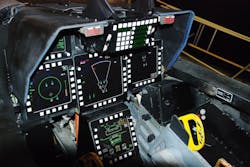Navy researchers ask Raytheon to develop and demonstrate two prototype advanced photonic radar systems
ARLINGTON, Va. – U.S. Navy researchers needed a company to develop and demonstrate two wideband passive photonic radar systems for precise tracking of targets of interest. They found their solution from Raytheon Technologies Corp. (RTX).
Officials of the Office of Naval Research in Arlington, Va., announced a $20.7 million three-year contract Tuesday to the RTX Raytheon segment in Tewksbury, Mass. for the Birdseye Yonder (BEYOND) project.
BEYOND is a 2023 Joint Capability Technology Demonstration (JCTD) that seeks to mature and integrate advanced, photonic-based radio frequency (RF) sensors (referred to as “Wall Fly”) that generate high-quality geolocation and signals intelligence of threats far beyond current capabilities.
This contract provides for building and demonstrating two prototype wideband passive sensor systems. BEYOND seeks to mature and integrate sensors into existing U.S. European Command sensor networks. It will demonstrate signals intelligence (SIGINT) and high-quality passive geolocation far beyond current capabilities, Navy researchers say.
The sensor technology is a 360-degree wideband passive geolocation, track, and target classification capability designed around physically assisted wideband correlator technology.
Photonic radar produces and analyzes radar signals with help from photonics rather than traditional RF engineering techniques. The frequency of the radar is in the RF, but lasers create and analyse the RF signals with high precision.
China, Russia and India reportedly have research projects in photonic radar to equip jet fighter aircraft with long-range detectors, position sensing, and 3D model target reconstruction.
Photonic radar reportedly could exceed the range and resolution of today's state-of-the-art RF-only radar to create high-resolution 3D images of airborne targets, and potentially could help defeat conventional stealth aircraft technology.
On this contract Raytheon will do the work in Tewksbury, Mass.; El Segundo, Calif.; and Arlington, Va., and should be finished by November 2026. For more information contact RTX Raytheon online at www.rtx.com/raytheon, or the Office of Naval Research at www.nre.navy.mil.
.
